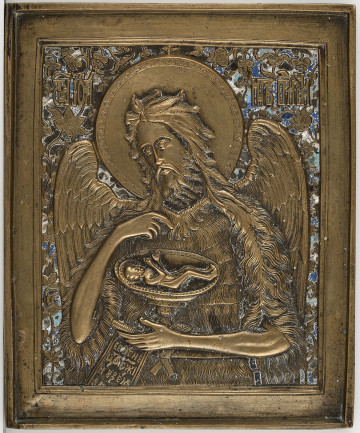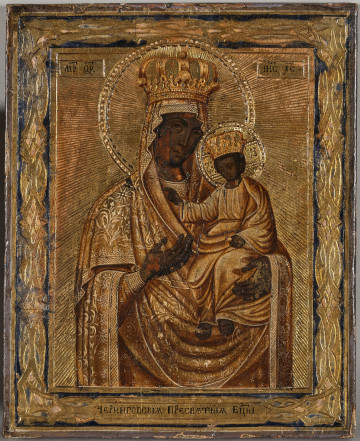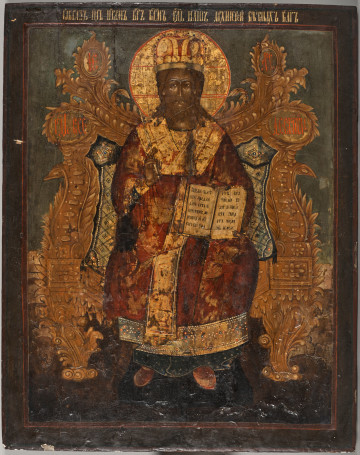
St. John the Baptist
20th century
Castle Museum in Łańcut
Part of the collection: Icons
Depictions of the Coronation of the Mother of God in the presence of the New Testament Holy Trinity took shape in Western European sacral art. The text of the Bible, when indicating the dignity of the Mother of God, does not refer to her royal title anywhere. Mary was already called the queen ruling on earth and in heaven in the first centuries of Christianity by the Church Fathers. In Byzantium, the Mother of Christ depicted in the dignity of her majesty was distinguished by the title of 'Basilissa' which is bestowed on rulers. Hymns were composed in her honour, the most beautiful of which are attributed to Romanos the Melodist, who lived in the 6th c. In the 14th-15th c., the text of the psalm "...the queen stands at your right hand, adorned with the gold of Ophir..." (Psalm 45:9) was used to visualise the Mother of God in royal robes and a crown on her heard, revering the enthroned Christ, shown in the majesty of a Byzantine ruler, together with John the Baptist. Although Mary was elevated above all creatures through the dignity of Divine Motherhood, Mother of God - the Queen, Mother of the Enthroned Son was not portrayed during coronation. From the second half of the 17th c., the influence of Western European sacral art began to increase in Russian icon painting. In European painting, the subject of the Coronation of Mary by God the Father in the presence of the Holy Spirit in the form of a dove has already been widespread since the 14th c. In response to the Protestant reticence or even unwillingness to glorify the person of the Mother of God, the cult of Mother of God the Queen developed in the Roman-Catholic Church, especially after the Council of Trent. In the lands of former Rus, despite the bans on the creation of non-canonical depictions issued by successive councils of the Orthodox Church of the Moscow Patriarchate, the influence of Western European iconography left its mark on icon painting, as can be seen on the presented icon. Teresa Bagińska-Żurawska https://orcid.org/0000-0002-9243-3967
Dimensions
height: 66 cm, width: 60 cm
Object type
Icons
Technique
oil
Material
canvas
Origin / acquisition method
decyzja administracyjna
Creation time / dating
Creation / finding place
Owner
Castle Museum in Łańcut
Identification number
Location / status

20th century
Castle Museum in Łańcut

19th (?) century
Castle Museum in Łańcut

1800 — 1850
Castle Museum in Łańcut
DISCOVER this TOPIC
Museum of King Jan III's Palace at Wilanów
DISCOVER this PATH
Educational path